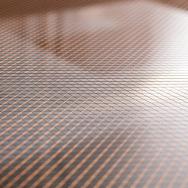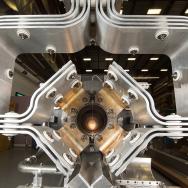New results from the MicroBooNE experiment at Fermi National Accelerator Laboratory deal a blow to a theoretical particle known as the sterile neutrino. For more than two decades, this proposed fourth neutrino has remained a promising explanation for anomalies seen in earlier physics experiments. Finding a new particle would be a major discovery and a radical shift in our understanding of the universe.
However, four complementary analyses released by the international MicroBooNE collaboration and presented during a seminar today do not show signs of the sterile neutrino. Instead, the results align better with the Standard Model of Particle Physics, scientists’ best theory of how the universe works.
“MicroBooNE has made a very comprehensive exploration through multiple types of interactions, and multiple analysis and reconstruction techniques,” said Bonnie Fleming, physics professor at Yale University and co-spokesperson for MicroBooNE. “They all tell us the same thing, and that gives us very high confidence in our results that we are not seeing a hint of a sterile neutrino.”
MicroBooNE is a 170-ton neutrino detector roughly the size of a school bus that has operated since 2015. The international experiment has close to 200 collaborators from 36 institutions in five countries. They used cutting-edge technology to record spectacularly precise 3D images of neutrino events to examine particle interactions in detail.
Neutrinos are one of the fundamental particles in nature, but among the most mysterious; scientists don’t know why their masses are so vanishingly small and whether they are responsible for matter's dominance over antimatter in our universe. This makes neutrinos a unique window into exploring how the universe works at the smallest scales.
“The new MicroBooNE results are an exciting milestone in neutrino research and showcase the capabilities of this type of neutrino experiment,” said University of Chicago Assoc. Prof. David Schmitz, a MicroBooNE collaborator.
Additional detectors of the same kind will soon come online at Fermilab that will further boost the ability to test the sterile neutrino hypothesis and enable the exploration of other possible explanations for the past anomalies.
First hints of sterile neutrinos
Neutrinos are neutral, incredibly tiny, and the most abundant particle with mass in our universe—though they rarely interact with other matter. They come in three known types—the electron, muon and tau neutrino—and can switch between these flavors as they travel. This phenomenon is called “neutrino oscillation.” Scientists can use their knowledge of oscillations to predict how many neutrinos of any kind they expect to see when measuring them at various distances from their source.
Starting around two decades ago, data from two particle beam experiments threw researchers for a loop.
In the 1990s, the Liquid Scintillator Neutrino Detector experiment at Los Alamos National Laboratory saw more particle interactions than expected. In 2002, the follow-up MiniBooNE experiment at Fermilab began gathering data to investigate the result in more detail; MiniBooNE scientists also saw more particle events than calculations predicted.
Sterile neutrinos emerged as a popular candidate to explain these odd results. While neutrinos are already tricky to detect, the proposed sterile neutrino would be even more elusive, responding only to the force of gravity. But because neutrinos flit between the different types, a sterile neutrino could impact the way neutrinos oscillate, leaving its signature in the data.
But studying the smallest things in nature isn’t straightforward. Scientists never see neutrinos directly; instead, they see the particles that emerge when a neutrino hits an atom inside a detector.
The MiniBooNE detector had a particular limitation: It was unable to tell the difference between electrons and photons (particles of light) emanating from a neutrino interaction. It was possible photons could be throwing off the numbers, so researchers needed a more nuanced detector. In 2007, the idea for MicroBooNE was born.
MicroBooNE: precision detector
The MicroBooNE detector uses more than 8,000 painstakingly attached wires to capture particle tracks. It’s housed in a 40-foot-long cylindrical container filled with 170 tons of pure liquid argon. Neutrinos bump into the dense, transparent liquid, releasing additional particles that the electronics can record. The resulting pictures show detailed particle paths and, crucially, distinguish electrons from photons.
MicroBooNE’s first three years of data show no excess of electrons—but they also show no excess of photons from a background process that might pinpoint an error in MiniBooNE’s data.
“We’re not seeing what we would have expected from a MiniBooNE-like signal, neither electrons nor the most likely of the photon suspects,” said Fermilab scientist Sam Zeller, who served as MicroBooNE co-spokesperson for eight years. “But that earlier data from MiniBooNE doesn’t lie. There’s something really interesting happening that we still need to explain.”
MicroBooNE ruled out the most likely source of photons as the cause of MiniBooNE’s excess events with 95% confidence and ruled out electrons as the sole source with greater than 99% confidence, and there is more to come. MicroBooNE still has half of its data to analyze and more ways yet to analyze it.
While the first analyses weighed in on the sterile neutrino, additional analyses could provide more information about exotic explanations. There’s even a chance it could still be a sterile neutrino, hiding in even more unexpected ways.
“The data is steering us away from the likely explanations and pointing toward something more complex and interesting, which is really exciting,” Zeller said.
Future neutrino exploration
The anomalous data seen by the earlier MiniBooNE and LSND experiments still need an explanation. So too does the very fact that neutrinos have mass, which is not predicted by the Standard Model. There are also tantalizing possibilities that neutrinos could help explain why there is so much matter in the universe, as opposed to a universe full of antimatter or nothing at all.
MicroBooNE is one of a suite of neutrino experiments on the Fermilab site. Two other pieces will soon join MicroBooNE: The ICARUS detector is set to begin gathering physics data soon, and the Short-Baseline Near Detector is planned to come online in 2023. Together with MicroBooNE, the three experiments form the Short-Baseline Neutrino Program at Fermilab.
The Short-Baseline Near Detector, or SBND, sits right at the mouth of the neutrino beam, so that physicists have a baseline for what the beam contains before it travels to MicroBooNE and ICARUS. Comparing the before-and-after will allow them to more precisely track any changes in the neutrinos as they travel.
“SBND will give us the capabilities for a broader and more definitive test of the sterile neutrino idea, including a few other ways it could manifest,” said Schmitz, who is co-spokesperson for SBND. “All in all, SBND will provide us 20 to 30 times more data than we have now, opening the door to explore many other intriguing questions about neutrinos.”
“Every time we look at neutrinos, we seem to find something new or unexpected,” said Justin Evans, a scientist at the University of Manchester and MicroBooNE co-spokesperson. “MicroBooNE’s results are taking us in a new direction, and our neutrino program is going to get to the bottom of some of these mysteries.”
Further ahead will be the Deep Underground Neutrino Experiment, a flagship international experiment hosted by Fermilab that already has more than 1,000 researchers from over 30 countries. DUNE will study oscillations by sending neutrinos 800 miles (1,300 km) through the earth to detectors at the mile-deep Sanford Underground Research Facility. The combination of short- and long-distance neutrino experiments will give researchers insights into the workings of these fundamental particles.
“We have some big, unanswered questions in physics that many experiments are trying to address,” Fleming said. “And neutrinos may be telling us where to find some of those answers. I think if you want to understand how the universe works, you have to understand neutrinos.”
More ways to engage: Visit the MicroBooNE website. Take a virtual tour inside the MicroBooNE detector. Watch the Even Bananas video series about neutrinos. Print your own “Intriguin g Neutrino” poster. See additional MicroBooNE images.
Funding: MicroBooNE is supported by the U.S. Department of Energy, U.S. National Science Foundation, Swiss National Science Foundation, U.K. Science and Technology Facilities Council, U.K. Royal Society, and European Union’s Horizon 2020.
Adapted from an article published by Fermi National Accelerator Laboratory.

